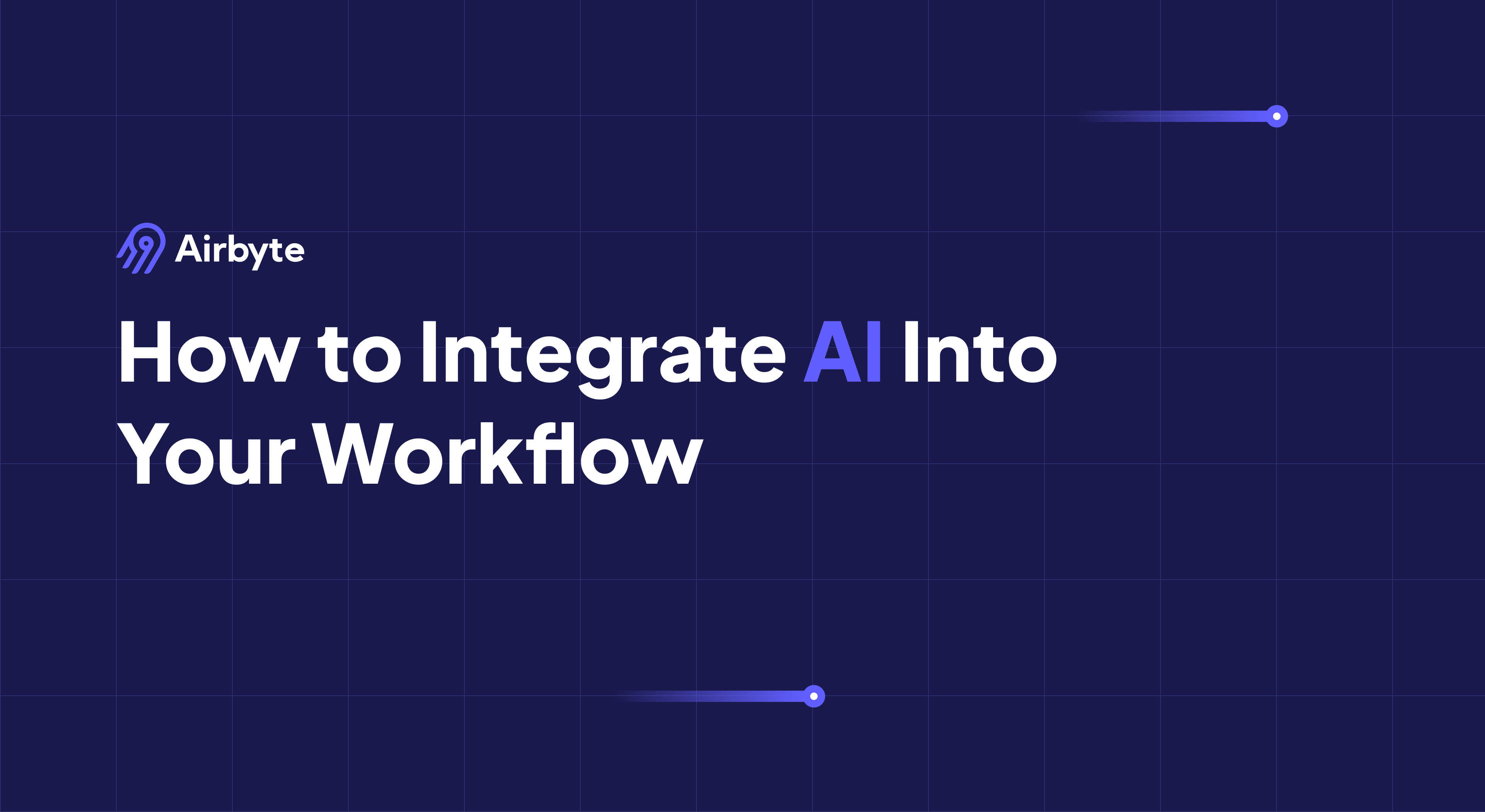Integrating AI Into Your Workflow
Summarize this article with:
✨ AI Generated Summary
AI integration in workflows automates repetitive tasks, enhances operational efficiency, and supports scalable data processing, leading to cost savings and improved decision-making. Key considerations before integration include organizational goals, existing infrastructure, ethical concerns, and budget planning. Popular AI tools vary by use case, such as automation (AI agents), chatbots, content creation, video editing, project management, and scheduling, with platforms like Airbyte facilitating seamless data integration to train AI models effectively.
AI is reshaping the way of working across different sectors and is becoming an essential component of workflows. AI-integrated workflow enhances operational efficiency by automating iterative tasks. This enables you to make precise data-driven decisions by facilitating accurate data processing with AI algorithms.
As your business expands, AI-integrated workflows offer the scalability needed to handle large volumes of data. These workflows are also cost-effective solutions, as they automate various manual tasks, reducing the need for a large human workforce, which cuts costs and optimizes resource usage.
This article illustrates the importance of AI integration within tools to enhance the outputs of your workflow. It also explains how to choose the right tool for AI integration in your organization. You can use this guide to understand how to integrate AI into your workflows and gain a competitive edge in your domain.
Introduction to AI Integration & Workflows

AI integration is the process of incorporating artificial intelligence capabilities into your existing software, work systems, or methods. It involves integrating AI algorithms and ML models into your core infrastructure to optimize repetitive and manual workflow tasks through automation.

The increase in the use of Generative AI, a subset of AI, is an excellent example of a boost in AI integration. GenAI enables you to generate AI Images, text, audio, video, and 3D models using ML and AI algorithms. It has become a valuable tool for workflow automation in the content creation and service industry. This reflects the rate at which AI is being adopted in diverse ecosystems.
According to Google Trends, the usage of AI for workflow automation in different sectors has grown steeply since 2021. This shows that many organizations are increasingly adopting AI-automated workflows to streamline their operations. This trend has been observed mostly in industries such as e-commerce, finance, healthcare, and legal firms.
Factors to Consider Before Integrating AI into Your Workflow
Some of the factors that you should consider before adopting AI integration within tools are as follows:
Your Organizational Goals
Identify the objectives you want to achieve with AI-integrated workflow. These could include simplifying repetitive tasks, saving time, improving the accuracy and efficiency of your operations, using an AI budgeting tool for smarter financial planning, comprehensive reporting, etc.
Current Workflow and Infrastructure
Analyze your existing workflows to understand their inefficiencies. For this, you should check workflows related to data management, manufacturing, marketing, sales, or finances. This simplifies identifying the areas where you can integrate AI to make operations fast and accurate. You should also monitor your current infrastructure and computational resources and how they can be integrated with AI.
Ethical Considerations
While AI usage has risen, problems such as hallucinations, which refer to the generation of misleading results by AI models, have also grown. The reasons for this issue are data biases, overfitting, inherent limitations, or flaws in prompt engineering. A lack of robust data privacy regulations has also led to the creation of faulty AI models. The increased spread of misinformation, false news, and deepfakes has further raised concerns about the usage of AI.
To avoid any such discrepancies, ensure that the data you are using in AI-integrated workflows is inclusive and taken from authentic sources. You should regularly test the AI workflows for fairness and keep the scope of human intervention in case of any anomalies.
Additionally, you must ensure that your AI workflows comply with robust data privacy regulations such as GDPR or HIPAA.
Cost
Figure out an estimated amount your organization can invest in deploying AI integration. The pricing of AI integration within tools depends on the complexity of the AI model, the cost of data processing, additional infrastructure requirements, and its ongoing maintenance.
The expense increases further if you are hiring staff who are experts in AI. To streamline these expenditures, you should first prepare a budget and analyze ROI before deploying AI integration in your workflows.
Choosing the Right Tools for Integration AI into the Workflow
When integrating AI into your workflow management tools, it is important to consider several factors to ensure successful implementation:
General Considerations for Choosing the Right Tools for AI Integration in Workflows
Identify Pain Points and Opportunities
First, identify the pain points that are consuming time, leading to inaccuracies, and affecting operational efficiency within your organization. Engage with your team and senior management to discuss these issues. This will help you understand opportunities for AI integration and choose the specific tools needed for each process.
Understand Your Data Needs
AI algorithms are an essential part of AI integration within the tools, and their effectiveness depends on access to clean and high-quality datasets. For this, you should first understand what kind of data you require and the source from which you can extract it. You should also invest in the necessary data processing infrastructure to clean and transform data into a standardized format.
Prioritize Ease of Use
The AI integration tools that you select should be simple and user-friendly. Your existing employees should be easily able to use these tools, even if they do not have much technical expertise. This lowers the learning curve and helps in the faster deployment of AI models for optimizing workflows. An easy-to-use tool also reduces the possibility of errors and saves time and cost that could go into rework.
Evaluate Scalability
Scalability is an imperative feature for any tool used for AI integration. As your business expands, you will need to handle a larger amount of data. For this reason, your tool should be scalable to accommodate the increase in data volume. A highly scalable tool also proves to be a cost-effective solution in the long term. This is because it prevents you from spending again on similar tools in the future to adapt to growing business needs.
Capability to Integrate with Existing Infrastructure
To ensure a hassle-free transition from manual to AI-automated workflows, you should see that the AI integration tools effortlessly connect with your existing infrastructure. Training your team on these tools before full-scale implementation will prevent any hindrance in workflow operations.
Calculate the Cost
Lastly, the costs of using AI integration tools should be within your budget. You should consider parameters such as licensing, deployment, and maintenance costs of the necessary infrastructure or software. You should also consider costs associated with training your existing staff or hiring new experts to manage and use these tools.
Use-based Selection of Tools for AI Integration in Workflows
Another way of choosing the right tool for AI integration is to consider the purpose for which you want to use it in your workflow. Here are some examples of prominent AI-integrated tools and their usage:
Automation
One of the most common use case of AI integration in workflow is to automate daily mundane tasks. For example, AI agentic workflows are a rising category of AI-automated workflows that use AI agents to streamline workflow operations.
AI agents are software designed to function autonomously and perform designated tasks. You can use tools like AI Agent, AgentGPT, and HyperWrite Assistant for this purpose.
Additionally, you can create custom AI agents by integrating Airbyte, a data movement platform, with frameworks like LangChain or LlamaIndex. These AI agents can be employed in various enterprise workflows for automated report generation, predictive analysis, or customer segmentation.
Chatbots
AI-powered chatbots help you to chat with LLM to get your queries resolved in a conversational way. You can use it for text-based queries, writing code, and performing mathematical calculations. ChatGPT, Zapier Central, Vondy, and Claude are some examples of AI chatbots.
Content Creation
Several content creation applications use AI to create content. These applications provide predefined templates or allow you to give prompts to create content according to your requirements.
Jasper, Copy.ai, and Anyword are some examples of AI tools that help you create image or text-based content.
Another versatile approach to content creation involves generating multimodal AI agents that can produce text, images, code, and interactive content. Orbofi is one such tool that enables users to transform ideas, characters, or documents into dynamic, voice-powered agents, streamlining creative workflows across various formats. Whether for developing engaging written content or dynamic multimedia assets, this AI engine helps optimize the content creation process.
Video Creation and Editing
You can now use AI-based software to create and edit high-quality videos, including an AI script to video generator.. This software provides features such as giving text or image prompts to create videos and removing backgrounds to enhance the visual experience of viewers. For users working on a Mac, there are also straightforward tools available to crop videos on mac, making it easy to trim unnecessary portions and maintain a polished final product.
Runway, Wondershare Filmora, and Descript are some AI-based video editing applications.
Project Management
AI-powered project management softwares is increasingly used by companies to ensure projects are completed in a timely manner. These tools assist in tracking status, managing deadlines, and generating automated reports.
Additionally, many of these platforms offer virtual assistants to resolve any project-related queries, enhancing overall project management. Some examples of AI-driven project management software are Asana, Any.do, and BeeDone.
Scheduling
With the help of AI scheduling assistants, you can now easily manage your meetings, onboarding interviews, and other time-based tasks. This software also assists in maintaining routine tasks such as hobby or exercise time by aligning them with your professional schedule.
Reclaim, Clockwise, and Motion are some examples of AI-based scheduling software.
Training the Team
Communicating beforehand with your employees, colleagues, senior authorities, and other stakeholders about the importance of AI integration within tools will help keep everyone in alignment with your objectives.
After this, you should provide training on how to integrate AI into operational workflows. Begin by assessing your team's current skills and identifying any knowledge gaps. Understanding this can help you develop a training curriculum that covers AI fundamentals, tool-specific training, workflow integration, and ethical responsibilities.
For instance, if you have a YouTube channel, you could use AI prompting to help train your editors in AI-based video editing applications. Start by introducing them to AI features of tools like Adobe Premiere Pro or Runway ML. Show them sample videos where these tools have been used for editing. Then, demonstrate how to use these AI features and assign them tasks to give them practical experience.
Fostering a learning culture and healthy communicative environment will assist employees in adapting to AI in their work. These practices will empower your team to leverage AI effectively and contribute to organizational success.
How Can You Integrate Airbyte into Your AI Workflows?
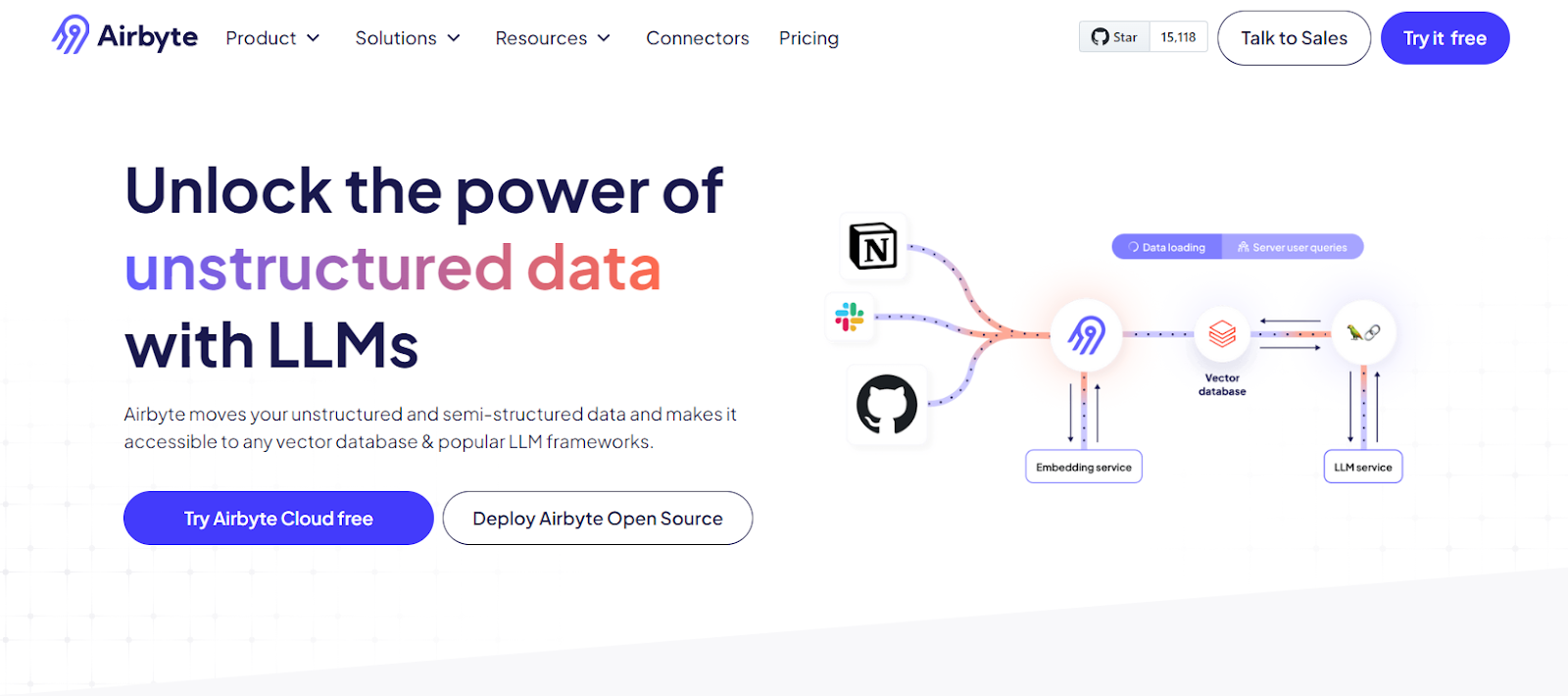
An AI-integrated workflow involves ingesting data from multiple sources and using it to train models, which can then be utilized to create applications for workflow automation. As a result, data integration is an imperative process in designing AI workflows. For streamlined data integration, you can opt to use Airbyte, one of the highly efficient data integration tools that simplifies the process of connecting various sources and destinations.
Airbyte is a data integration platform that offers an extensive library of 350+ connectors. You can use these connectors to extract structured and unstructured data from various sources. If your organization has unique processes or uses custom tools, Airbyte empowers you with greater flexibility through its CDK. With the CDK, you can quickly build custom connectors within 30 minutes. You can then transform the extracted data by integrating Airbyte with a dbt to convert it into a standardized format.
Some of the key features of Airbyte are as follows:
- PyAirbyte: Airbyte offers PyAirbyte, a Python library that enables you to extract data from different sources using Airbyte connectors into your Python framework. You can also use this library to extract raw data, which can be used for further LLM operations by integrating Airbyte with frameworks like OpenAI.
- GenAI Workflow Management: You can manage your AI workflow using Airbyte. The platform allows you to directly load extracted unstructured data into vector databases like Pinecone or Weaviate. This data can be processed and used to train AI models to perform sentiment analysis, text summarization, and object recognition in workflow.
- Change Data Capture: Airbyte's change data capture (CDC) feature enables you to capture changes made at the source and instantly reflect them at the destination database. This facilitates faster data synchronization between data sources and the target system, ensuring accurate response generation by AI-powered applications.
- Data Security: To facilitate data privacy, Airbyte complies with the provisions of data regulatory mechanisms like GDPR, HIPAA, and CCPA. It also offers strong data security mechanisms through single sign-on (SSO) and role-based access control features. This helps in training AI models based on standardized and secure datasets.
Consider a real-life example of integrating AI into business workflow. For instance, you work for an e-commerce company, and you want to improve your customer service by introducing AI in your workflow. To accomplish this, you can use Airbyte connectors to extract data from sources such as Zoho CRM, Google Analytics, or social media platforms like Twitter. You can then load this data in consolidated form into a data warehouse or data lake.
The integrated data can be used to train algorithms or models for creating AI and ML-based applications. These applications can help you optimize your customer support workflows by generating timely responses or segmenting customers for analytics.
Let’s learn how Airbyte facilitates reliable data integration for implementing AI workflow. You can follow the below-mentioned steps to achieve this:
Step 1: Add a Source
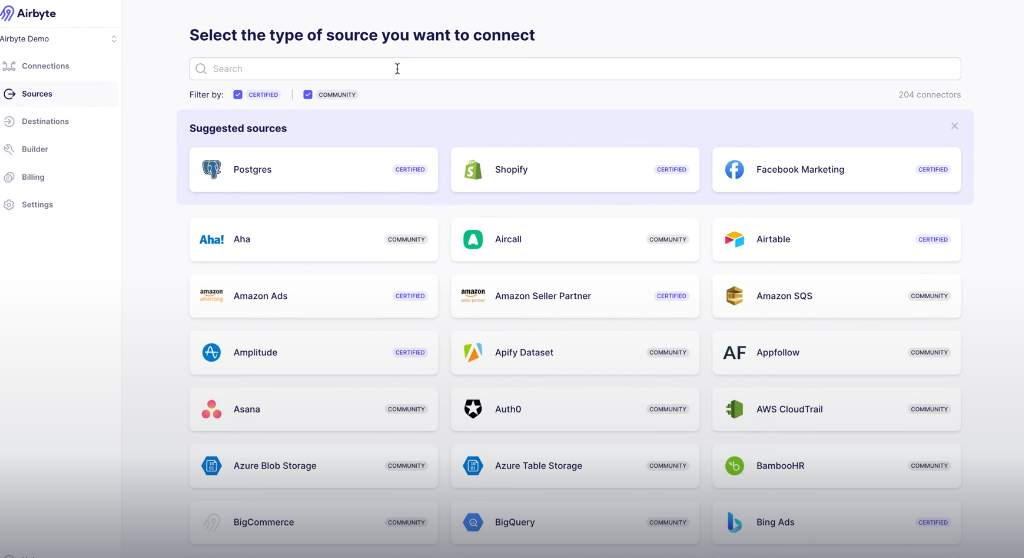
To set up a source in Airbyte, log in to your Airbyte account. Now, go to the navigation bar on the left side of Airbyte’s dashboard and click on the Sources. Here, you will see a list of all the available sources, and you can type the name of your desired source in the Search box. After this, enter all the required details on the setup page and then click the Set up Source button to complete the source configuration.
Step 2: Add a Destination
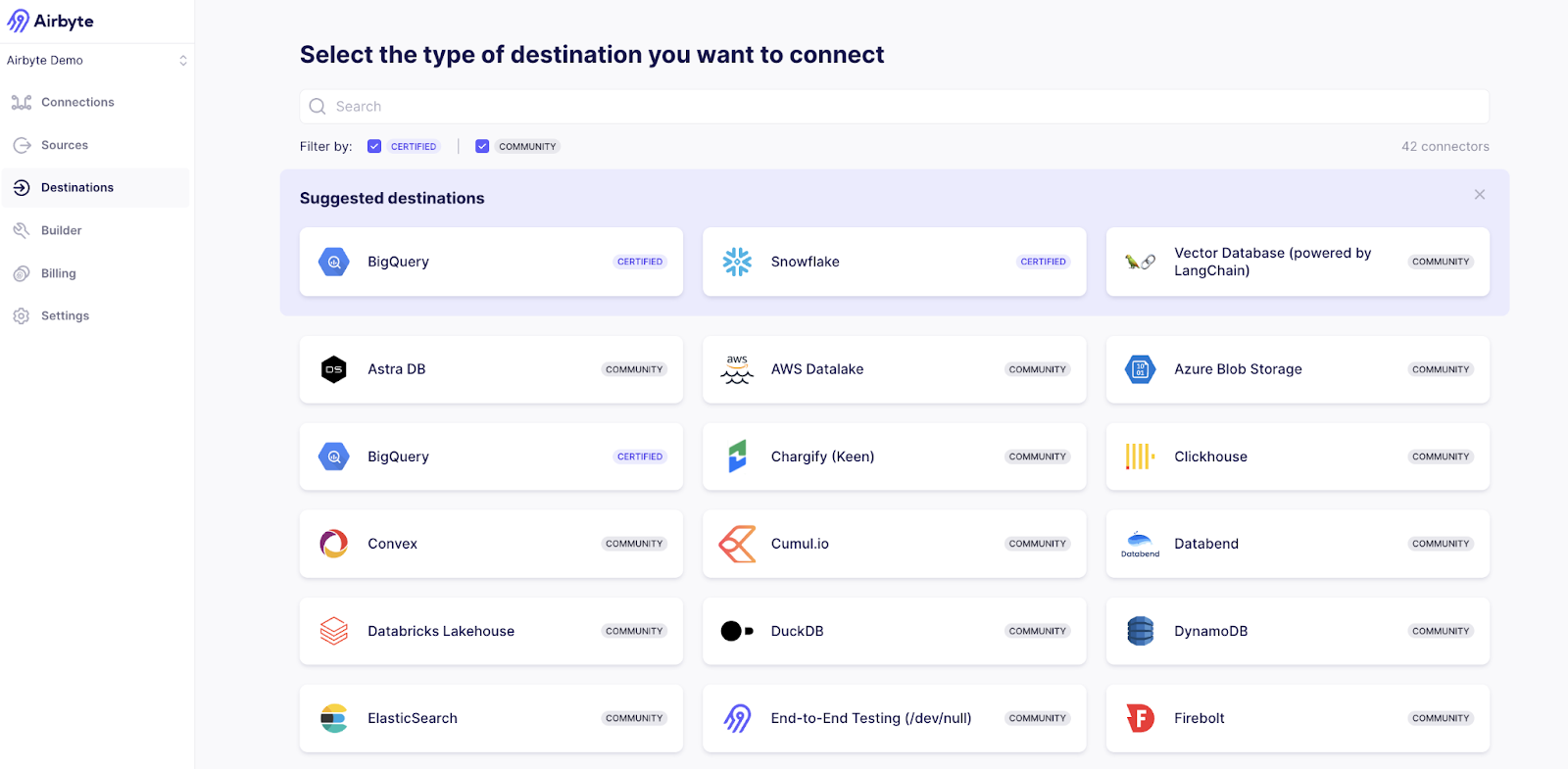
To set up a destination, again go to the navigation bar on the left and click on the Destinations from the dashboard. Then, type the destination where you want to integrate your data in the Search box. Click the destination's image icon to go to the setup page. Here, enter all the required details and click on the Set up Destination button to complete the configuration of the destination in Airbyte.
Step 3: Set up Connection
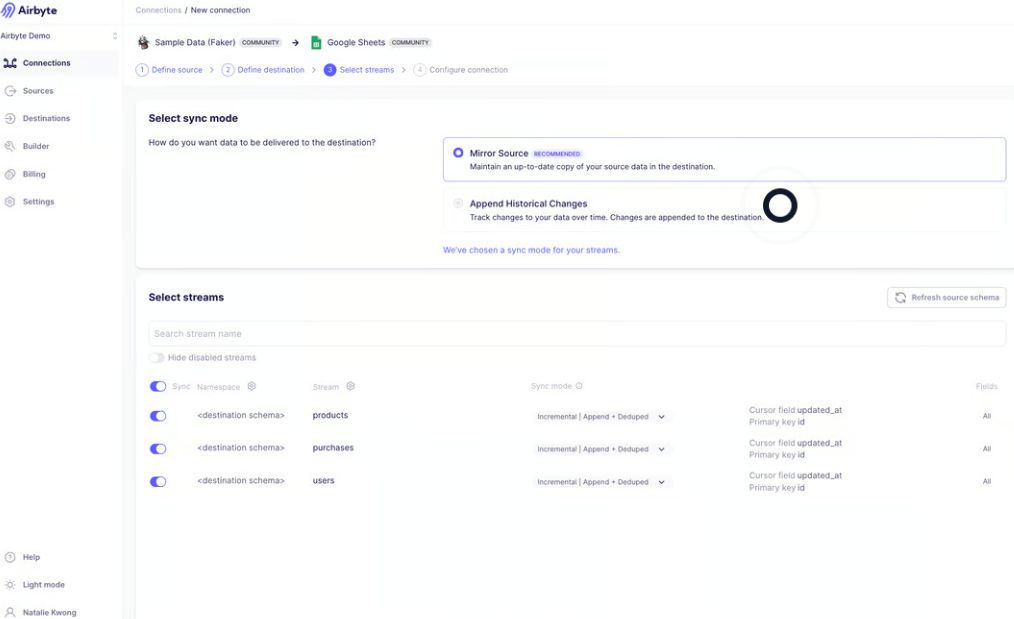
To configure a connection, click on the Connections. Specify the source and destination that you are using for data movement. Then, select how you want to sync your data, sync mode, and other relevant information to ensure easier data transfer.
After this, click Next and enter the frequency of data syncing between source and destination. Then, click the Set up Connection button.
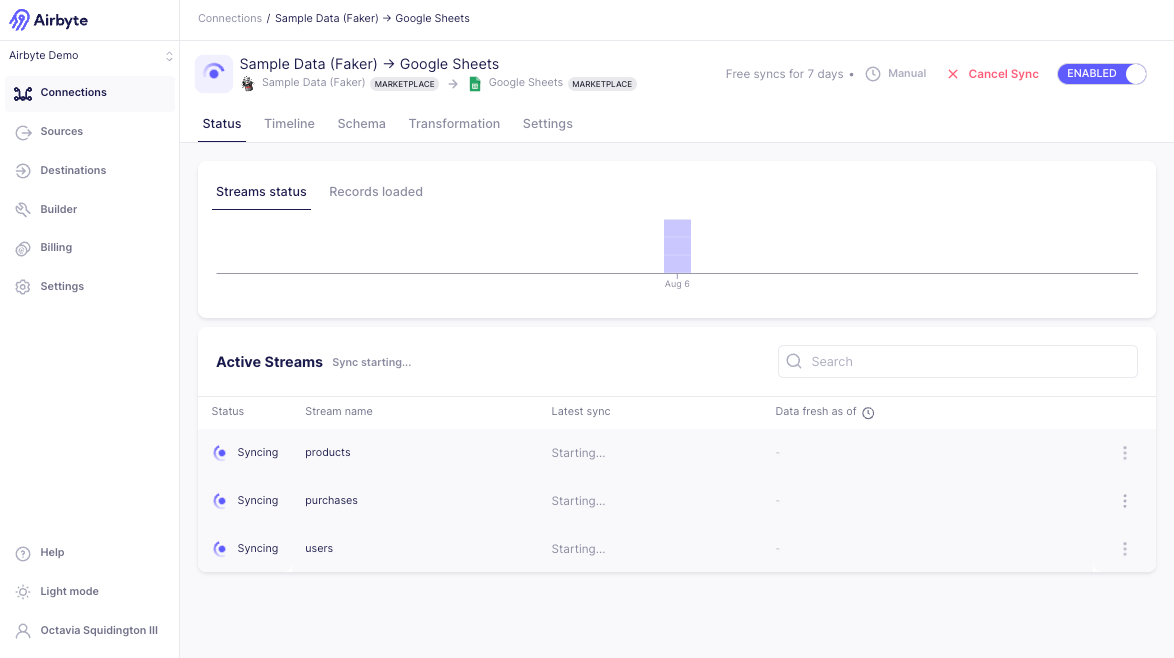
You can use this integrated data to train AI algorithms and ML models to conduct sentiment analysis and predictive analysis and understand trends in your customer data. You can also use AI to prepare chatbots to solve customer queries and FAQs. This use case shows how you can utilize Airbyte to optimize your customer support workflows using AI technology.
Conclusion
AI integration in workflows has the potential to automate repetitive tasks and improve the accuracy and efficiency of various operational processes. This blog gives you an overview of the importance of AI integration within tools of your existing workflows. It explains factors to consider while choosing an AI tool and provides examples of AI tools based on their use cases.
When selecting a tool for AI integration within your organizational workflows, consider your automation goals, resources, costs, and integration capabilities.

